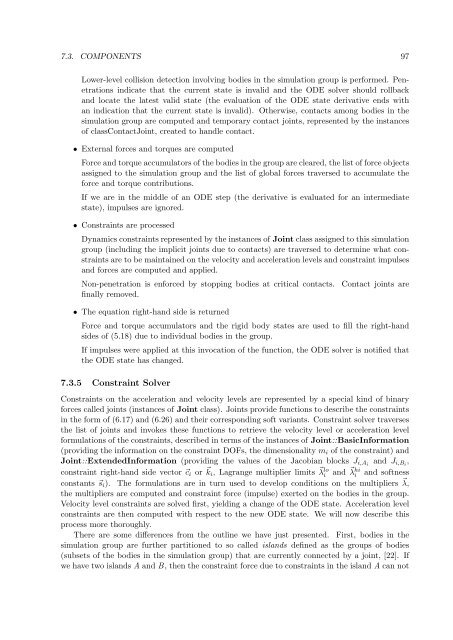thesis - Computer Graphics Group - Charles University - Univerzita ...
thesis - Computer Graphics Group - Charles University - Univerzita ...
thesis - Computer Graphics Group - Charles University - Univerzita ...
Create successful ePaper yourself
Turn your PDF publications into a flip-book with our unique Google optimized e-Paper software.
7.3. COMPONENTS 97<br />
Lower-level collision detection involving bodies in the simulation group is performed. Penetrations<br />
indicate that the current state is invalid and the ODE solver should rollback<br />
and locate the latest valid state (the evaluation of the ODE state derivative ends with<br />
an indication that the current state is invalid). Otherwise, contacts among bodies in the<br />
simulation group are computed and temporary contact joints, represented by the instances<br />
of classContactJoint, created to handle contact.<br />
• External forces and torques are computed<br />
Force and torque accumulators of the bodies in the group are cleared, the list of force objects<br />
assigned to the simulation group and the list of global forces traversed to accumulate the<br />
force and torque contributions.<br />
If we are in the middle of an ODE step (the derivative is evaluated for an intermediate<br />
state), impulses are ignored.<br />
• Constraints are processed<br />
Dynamics constraints represented by the instances of Joint class assigned to this simulation<br />
group (including the implicit joints due to contacts) are traversed to determine what constraints<br />
are to be maintained on the velocity and acceleration levels and constraint impulses<br />
and forces are computed and applied.<br />
Non-penetration is enforced by stopping bodies at critical contacts. Contact joints are<br />
finally removed.<br />
• The equation right-hand side is returned<br />
Force and torque accumulators and the rigid body states are used to fill the right-hand<br />
sides of (5.18) due to individual bodies in the group.<br />
If impulses were applied at this invocation of the function, the ODE solver is notified that<br />
the ODE state has changed.<br />
7.3.5 Constraint Solver<br />
Constraints on the acceleration and velocity levels are represented by a special kind of binary<br />
forces called joints (instances of Joint class). Joints provide functions to describe the constraints<br />
in the form of (6.17) and (6.26) and their corresponding soft variants. Constraint solver traverses<br />
the list of joints and invokes these functions to retrieve the velocity level or acceleration level<br />
formulations of the constraints, described in terms of the instances of Joint::BasicInformation<br />
(providing the information on the constraint DOFs, the dimensionality mi of the constraint) and<br />
Joint::ExtendedInformation (providing the values of the Jacobian blocks Ji,Ai and Ji,Bi ,<br />
constraint right-hand side vector ci or ki, Lagrange multiplier limits λ lo<br />
i and λ hi<br />
i and softness<br />
constants si). The formulations are in turn used to develop conditions on the multipliers λ, the multipliers are computed and constraint force (impulse) exerted on the bodies in the group.<br />
Velocity level constraints are solved first, yielding a change of the ODE state. Acceleration level<br />
constraints are then computed with respect to the new ODE state. We will now describe this<br />
process more thoroughly.<br />
There are some differences from the outline we have just presented. First, bodies in the<br />
simulation group are further partitioned to so called islands defined as the groups of bodies<br />
(subsets of the bodies in the simulation group) that are currently connected by a joint, [22]. If<br />
we have two islands A and B, then the constraint force due to constraints in the island A can not
















